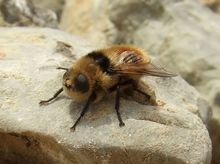With warm spring and summer weather approaching, horse owners need to prevent bot flies from attacking their horses. During warm weather, bot flies swarm around horses. These parasites, of the species Gasterophilus, lay numerous tiny white eggs on the haircoats of horses.

Horse bot fly emerging from larva
These parasites, of the species Gasterophilus, lay numerous tiny white eggs on the haircoats of horses causing pain and irritation in the horse's mouth and as adult flies develop from larvae, they may cause gastrointestinal problems.
© 2016 by Karsten Heinrich
Bot eggs are not only aesthetically unpleasing, but once they have hatched into larvae, they also may cause the horse pain and irritation in the mouth. Adult flies that have developed from larvae may also cause various gastrointestinal problems.
In the adult stage, this winged insect looks similar to a bee, and can be seen in stables and outdoors hovering around the legs of the horse.
Horses infected by bots often develop no clinical signs of disease. There must usually be a large number of bot eggs present before the animal becomes sick from the infection.
When grooming your horse, you may notice tiny yellow specks attached to the hair on the horse's legs, neck or face. These tiny specks are the eggs of the bot fly. A single bot fly may lay as many as 1000 eggs on your horse.
The eggs hatch approximately 10 days after being deposited, and may hatch in response to the moisture and warmth caused by the horse licking the area. The larvae may be ingested by the horse, or may crawl to the mouth where they can cause irritation to the gums. Subsequently, they bury themselves in the tongue, gums or lining of the mouth and remain for approximately 28 days.
Following this phase, the larvae molt and enter their second stage of development and migrate to the horse's gastrointestinal tract. The larvae attach themselves to the lining of the stomach and remain attached for the next 9 to 12 months. During this time, the larvae feed on the fluids from the body of the horse.
Toward the later part of this period, the larvae molt again. The larvae in this third stage have grown to approximately 1/2 to 3/4 of an inch and have a characteristic yellowish color and exhibit spines that can be used to identify the species.
After the third stage larvae mature, they detach from the gastrointestinal tract wall and are passed in the manure. The larvae burrow into the soil or dried manure where they pupate and remain for the next one to two months. This stage of the life cycle occurs between late winter and early spring.
Deworming treatments are very successful in treating severe cases of infection, and there are several effective tools for removing the eggs from the hair.
Prevention relies on keeping the horseâs haircoat free of bot eggs. Dull blades, fine-toothed combs, and special pumice stones are effective devices. These objects help to scrape and remove the eggs from the haircoat of the infected horse. The use of fly repellents may be helpful in preventing flies from landing on the horse and depositing eggs. Also an effective tool, a fly mask is made from a mesh-like material, and fits around a horseâs face and ears while leaving its mouth free.
Daily removal of manure to a distant location, or to a compost pile, will reduce the number of pupae that survive and turn into adult flies. Removal of the eggs from the horse's coat may also reduce the survival of future generations.
Probably the most important activity to reduce the potential for bot flies is to follow your veterinarians directions for routine worming. You veterinarian can advise on the potential for bot flies in your area, and can also recommend the timing of worming that will kill the majority of the bot fly larvae.
On rare occasions, humans have been infected with bot fly larvae. The first stage larvae have been found migrating in the skin (cutaneous myiasis) and in the eye (ocular myiasis). Horse bots have also been reported in the stomach of humans.
Because of this, you may want to wear gloves when removing bot eggs and should always wash your hands with soap and water after contact. Avoid rubbing your eyes or touching your mouth when removing bot fly eggs.
